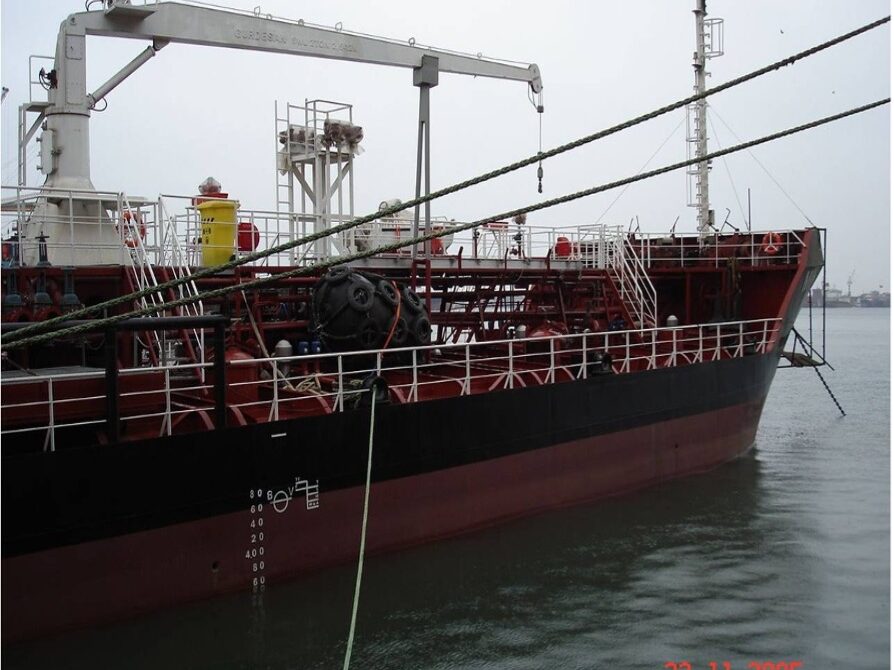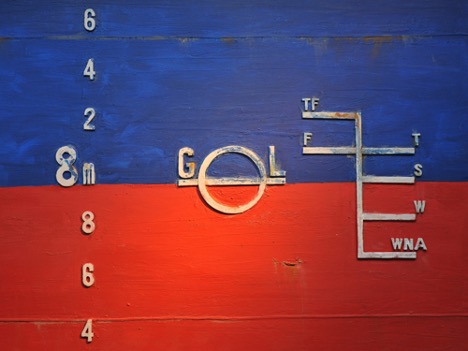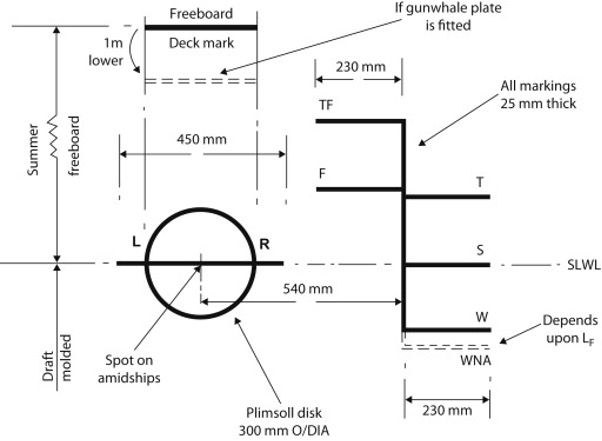Merchant ships are purposely built to carry cargo, but for safety reasons, there is a need to set a legal limit on how much cargo can be loaded onto a ship. By establishing such restrictions, the possibility of the ship sailing with insufficient freeboard and reserve buoyancy is reduced. In order to minimize overloading on merchant ships, the Load Line idea was developed in Britain in the 1870s.
A load line, also called the Plimsoll mark, is a marking indicating the extent to which the weight of a load may safely submerge a ship, by way of a waterline limit.

One important consideration for merchant ships is optimum loading, that is a vessel must be fully loaded commensurate with the type of vessel and its strength. A load line’s primary function is to set a legal upper limit on how much goods can be loaded onto a ship. In this article, I’ll talk about the loadline, its development, and how it has helped improve safety in the maritime industry.
What Is The Plimsoll Line?
A ship’s waterline is the line where its hull meets the surface of the water. The Plimsoll line is a mark that is placed on the side of a ship that indicates the ship’s maximum loading level. This line is also known as the load line or the water line. The Plimsoll line was first introduced in 1876 as a way to improve safety at sea.
The Plimsoll line is easily recognizable, as a horizontal line painted on the side of a ship. This line indicates the maximum safe draft for the vessel, based on its cargo capacity and the water conditions in which it will be sailing. If the waterline rises above this mark, it indicates that the ship is carrying too much weight of cargo and fuel and is at risk of capsizing.
The Plimsoll line is named after its creator, Samuel Plimsoll, who is also known as the “sailor’s friend.” Samuel Plimsoll was a member of the British Parliament from 1824 to 1898. As a member of parliament, he was concerned about the loss of ships and crews that occurred as a result of vessel overloading. In the year 1876, he was successful in convincing Parliament to approve the Unseaworthy Ships Bill.
This legislation required that the sides of a ship be marked with a line that would be submerged if the ship was overloaded. He is credited with saving the lives of many sailors by his advocacy for the placement of a line on ships that would indicate when the vessel was overloaded and in danger of sinking.
The History of the Plimsoll Line
When merchants first started transporting their goods by sea, they quickly realized how important it was to load their ships in the correct manner. In severe weather or stormy seas, a ship that was overloaded with cargo could capsize and sink. In the 19th century, it was so bad to the extent that overloading and poor repair made some ships dangerous enough to be referred to as ‘coffin ships.
Sailors became so worried about the unseaworthiness of ships that some flatly refused to go to sea in unseaworthy ships even though several of them ended up being jailed for this. In 1855 a group of sailors petitioned Queen Victoria that they had been found guilty of desertion because they had complained about going to sea in unseaworthy ships.
At the same time, a prison inspector after an investigation found out and reported that nine out of twelve convicts in the southwest England jails were sailors who had been imprisoned for 12 weeks for refusing to embark on ships they deemed unseaworthy.

Plimsoll was a member of the British Parliament who campaigned for better safety regulations for ships. The line, which is now referred to as the Plimsoll line in honor of him is located amidships on cargo vessels’ hulls on both port and starboard sides is still used by the shipping industry all over the world.
How Is The Plimsoll Line Used Today?
The Plimsoll line is used as a reference mark on a ship’s hull to indicate the maximum depth to which the vessel may be safely immersed when loaded with cargo. This depth varies with a ship’s dimensions, type of cargo, time of year, and the water densities encountered in port and at sea.
Once these factors have been determined, a shipmaster can determine the appropriate draft to load to in order to ensure it does not become submerged during each leg of the voyage.
When a ship is loaded, the line is not to be submerged. However, the water can reach different parts of the line, depending on the water’s temperature, saltiness, time of year, and geographic location of the ship. The basic symbol, of a circle with a horizontal line passing through its center, is now recognized worldwide.
Because the world is divided into zones based on the weather severity, it is necessary to ensure the loadine mark is not submerged when moving through different zones. To achieve this, a vessel must be loaded so that, when she arrives in the zone or area in question, her mean draught will not exceed the maximum draught permitted in the second zone or area.
This requirement applies to vessels traveling between zones or areas, each of which has its own load line and the calculation is a normal cargo calculation process.
Where seagoing vessels travel through rivers or other inland waters, heavier loading is allowed to account for the amount of fuel, water, and other supplies needed for consumption between the starting point and the open sea. A “Dock Water Allowance” is established to account for the difference in density while loading in fresh water, dock, or river water that has a density lower than that of seawater.
Today, the Plimsoll line is used as a regulatory measure to ensure that ships do not exceed their maximum loading level. This is important because if a ship exceeds its maximum loading level, it can become unstable and capsize.
The complete Load line markings consist of 3 vital parts.
Deck Line – It is a horizontal line measuring 300mm by 25mm. It passes through the upper surface of the freeboard.
Load Line Disc – It is 300mm in diameter and 25mm thick round-shaped disc. It is intersected by a horizontal line. The upper edge of the horizontal line marks the ‘Summer saltwater line’ also known as the ‘Plimsoll Line’.
Load Lines – Load lines are horizontal lines extending forward and aft from a vertical line placed at a distance of 540mm from the center of the disc. They measure 230mm by 25mm. The upper surfaces of the load lines indicate the maximum depths to which the ships may be submerged in different seasons and circumstances.

Conclusion.
The line has served as an international standard since 1876 and is still in use today. It is compulsory on all merchant vessels and its purpose is to prevent overloading, which can lead to severe problems such as capsizing. The Plimsoll line has saved countless lives and continues to be an essential safety feature on all merchant vessels.
- Types of Gas Carriers as per IGC Code – April 22, 2025
- Wind-Assisted Propulsion Systems (WAPS): A Game Changer for Maritime Decarbonization – February 6, 2025
- 10 Boat Salvage Yards in California – January 25, 2025





